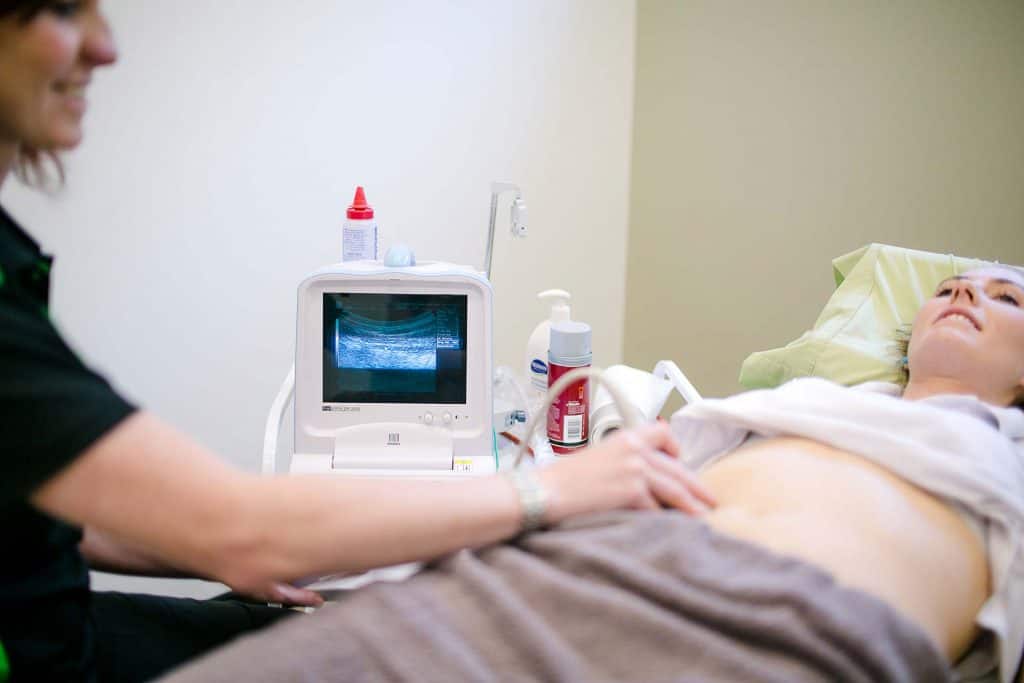ultrasound

Ultrasound For Physiotherapy
While most patients are familiar with the use of ultrasounds for pregnancy, they may be surprised at the scope of health ailments, diagnosis and treatment it can be used for.
At Miami Physio, we perform real-time ultrasound imaging in Mandurah and Lakelands as a means to assess our patients and treat their concerns.
What is Real Time Ultrasound Imaging?
Ultrasound imaging uses high-frequency sound waves to create a black and white image of the area of concern within your body.
A small probe, known as a transducer or hand-held scanner, and gel is positioned on the skin. This probe emits high-frequency sound waves, which travel through the body and bounce off structures in your body, such as internal organs or muscles.
These high-frequency sound waves then bounce back to the probe, which captures the real-time structure and movement of organs, muscles and tendons, before a computer displays the sound waves as black and white moving images on the screen in front of you.
What Can It Be Used For?
As we mentioned earlier, when performed by a trained sonographer, ultrasound imaging is an effective and generally non-invasive way to identify and diagnose health issues within a patient, such as abnormalities in the heart and blood vessels to issues in the kidney, bladder and uterus.
Real Time Ultrasound Imaging
Our physiotherapists are trained in using ultrasound imaging to assess and train bladder function, pelvic floor function and core muscle (abdominal and back) function in your body.
Real-Time Ultrasound Imaging (RTUI) allows your physiotherapist to visualise your muscles in your area of concern to see whether these muscles are working properly, which takes the guesswork out of retraining your important muscles and is far more accurate than using our hands alone to feel your muscles.
By visualising your muscles in real-time through RTUI, we can ensure that you are contracting your muscles correctly while performing an exercise. If we find your muscles are not contracting how they should be, we can help you to retrain your muscles and rehabilitate them where required.


How Is RTUI Performed?
As with other ultrasound imaging, RTUI is safe and painless.
Your physiotherapist and you will be able to see the ultrasound image on the screen, which will show in real-time how your muscles contract and relax as you follow the directions of your physiotherapist.
This visual biofeedback is very effective at helping you to correctly learn your exercises and correct any faults in your technique.
Muscle Groups Commonly Assessed with RTUI
Some muscle groups we commonly examine are:
- Abdominals
- Lumbar spine muscles
- Pelvic floor muscles
What Do You Need to Do During RTUI?
In order to assess your muscle groups, your physiotherapist will coach you through relaxing and contracting certain muscles.
If your physiotherapist is interested in assessing your stomach and pelvic floor muscles, you will lay on your back as the gel and transducer are used to broadcast your muscle movements onto the screen. You will need to have a half-full bladder to get an optimal image when your physiotherapist is assessing your bladder or pelvic floor. So, make sure you have a drink of water in the hour before your treatment and don’t go to the bathroom in the hour before your appointment.
For deep back muscles, your physiotherapist will place the gel and transducer on your lower back.
RTUI in Mandurah and Lakelands
Don’t delay your trip to the physiotherapist any longer. At Miami Physio, our trained and highly professional team of physiotherapists can perform ultrasounds in Mandurah and Lakelands as part of your assessment and subsequent treatment plan.
The non-invasive RTUI assessment is a great option for those experiencing chronic back pain, pelvic floor and continence issues and even pre & post-surgical (urology, gynae or spinal surgery) patients.
Contact Miami Physio today to get started on your journey to improving your exercise, strengthening your muscles and getting on top of that chronic pain.

RTUI can be helpful if you have low back, pelvic or hip pain, or muscular disorders such as recurrent hamstring or groin strains. RTUI allows your physiotherapist to visualise your muscles in your area of concern to see whether these muscles are working properly. This takes the guesswork out of retraining your important muscles and is far more accurate than using our hands alone to feel your muscles. By visualising your muscles, we can ensure that you are contracting your muscles correctly, or if not, we can teach you how to use your muscles properly. This means, your exercise program will get the results you want faster!
RTUI is safe and painless. Your physiotherapist and you will be able to see the screen and watch your muscles contract as you follow the directions of your physiotherapist. This visual biofeedback is very effective at helping you to correctly learn your exercises and correct any faults in your technique.
